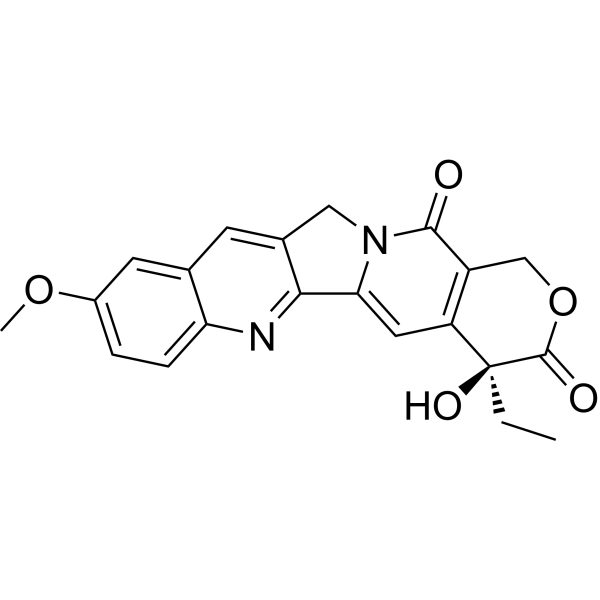
10-Methoxycamptothecin
CAS No. 19685-10-0
10-Methoxycamptothecin( —— )
Catalog No. M28371 CAS No. 19685-10-0
10-Methoxycamptothecin is a natural bioactive derivative of camptothecin (CPT) isolated from Camptotheca acuminata and possesses high anti-cancer properties.
Purity : >98% (HPLC)
 COA
COA
 Datasheet
Datasheet
 HNMR
HNMR
 HPLC
HPLC
 MSDS
MSDS
 Handing Instructions
Handing Instructions
| Size | Price / USD | Stock | Quantity |
| 5MG | 88 | Get Quote |


|
| 10MG | 141 | Get Quote |


|
| 25MG | 240 | Get Quote |


|
| 100MG | Get Quote | Get Quote |


|
| 200MG | Get Quote | Get Quote |


|
| 500MG | Get Quote | Get Quote |


|
| 1G | Get Quote | Get Quote |


|
Biological Information
-
Product Name10-Methoxycamptothecin
-
NoteResearch use only, not for human use.
-
Brief Description10-Methoxycamptothecin is a natural bioactive derivative of camptothecin (CPT) isolated from Camptotheca acuminata and possesses high anti-cancer properties.
-
Description10-Methoxycamptothecin is a natural bioactive derivative of camptothecin (CPT) isolated from Camptotheca acuminata and possesses high anti-cancer properties.
-
In Vitro——
-
In Vivo——
-
Synonyms——
-
PathwayOthers
-
TargetOther Targets
-
RecptorMEK|ERK|PI3K
-
Research Area——
-
Indication——
Chemical Information
-
CAS Number19685-10-0
-
Formula Weight378.38
-
Molecular FormulaC21H18N2O5
-
Purity>98% (HPLC)
-
SolubilityIn Vitro:?DMSO : 8.33 mg/mL (22.01 mM)
-
SMILESCC[C@@]1(O)C(=O)OCc2c1cc1-c3nc4ccc(OC)cc4cc3Cn1c2=O
-
Chemical Name——
Shipping & Storage Information
-
Storage(-20℃)
-
ShippingWith Ice Pack
-
Stability≥ 2 years
Reference
1.Perera Córdova WH, et al. Bufadienolides from parotoid gland secretions of Cuban toad Peltophryne fustiger (Bufonidae): Inhibition of human kidney Na(+)/K(+)-ATPase activity. Toxicon. 2016 Feb;110:27-34.
molnova catalog



related products
-
N-Acetyl lysyltyrosy...
N-Acetyl lysyltyrosylcysteine amide is a non-toxic, potent, reversible, and specific myeloperoxidase (MPO) tripeptide inhibitor that effectively inhibits MPO production in vivo, attenuates neuronal damage, preserves brain tissue and neurological function post-stroke, and inhibits MPO-dependent hypochlorite (HOCl) production, protein nitration, and LDL oxidation.
-
Scopolamine
Scopolamine, a nonselective muscarinic receptor antagonist, induces distinct behaviors of attenuated motility and C-like hyperactivity.
-
[(2-Methoxyphenoxy)M...
[(2-Methoxyphenoxy)Methyl]Oxirane is a natural product.



 Cart
Cart
 sales@molnova.com
sales@molnova.com


